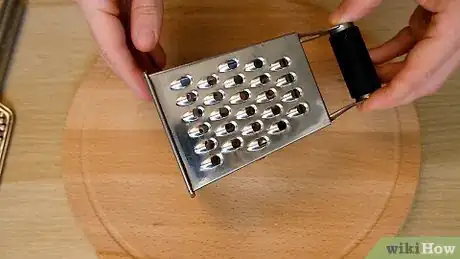wikiHow is a “wiki,” similar to Wikipedia, which means that many of our articles are co-written by multiple authors. To create this article, 17 people, some anonymous, worked to edit and improve it over time.
There are 7 references cited in this article, which can be found at the bottom of the page.
The wikiHow Culinary Team also followed the article's instructions and verified that they work.
This article has been viewed 201,073 times.
Learn more...
Cheese is the ultimate garnish. Though grating cheese is a very simply task, there are so many ways to slice this savory treat. Here are a few "grate" ways to shred your own cheese.
Steps
Using a Microplane
-
1Grate cheese using a microplane cheese grater. A microplane cheese grater consists of a handle attached to a long, flat grate with small, sharp teeth.[1] Although they are usually used for zesting lemons or grating garlic, they are perfectly serviceable when it comes to grating cheese.
- Because microplanes tend to produce smaller pieces of grated cheese, they are best used with hard cheeses such as Parmesan or Pecorino. Grating a soft cheese like mozzarella with a microplane would only give you a mushy mass instead of cleanly grated cheese.
-
2Unwrap your block of cheese. If it is too large to hold comfortably with one hand, slice it into manageable pieces with a knife. Err on the side of larger rather than smaller — there's less of a chance you'll hurt yourself with a big piece of cheese.Advertisement
-
3Holding the microplane over a plate or board, gently swipe the cheese against the grate using an up-and-down motion. Continue until you have the desired amount.
-
4Tap the metal end of the grater lightly against the edge of the plate to release excess trimmings. Use a pastry brush, if necessary, to remove all the cheese trimmings from the microplane.
-
5Switch out your microplane size depending on what you're using cheese for. Microplane graters come in a variety of sizes ranging from fine to coarse.[2] Finely shredded cheese can be used as the top layer of a freshly made pizza. Medium shredded cheese is thicker and a nice topping for baked potatoes or salads. Coarsely grated cheese is the thickest and can be used to garnish pasta.
Using a Box Grater
-
1Use a box grater to shred your cheese. A box grater is four sided, with each side having differently sized teeth.
- Because box grates tend to have larger teeth, they work well with softer cheeses such as mozzarella or havarti.
- Choose whichever grater plate suits the dish. The medium sized holes are great for garnishing tacos, but not so much for making crumb-like Parmesan to go on Spaghetti.
-
2Keep your cheese medium to large sized. This will prevent you from scraping your fingers before you have the desired amount of shredded cheese.
-
3Lightly coat the outside of the grater plate you will be using with cooking spray. This will make the cheese glide easier.[3]
-
4Let your box grate decide how you'll use it. For box graters without a handle, hold the cheese and grater over a large bowl. For graters with a handle, place the end of the grater on a cutting board.
-
5Rub the cheese against the grater in an up-and-down motion. Once you reach the end of the cheese, rub it with your palm to avoid scraping your knuckles.[4]
Using a Rotary Grater
-
1Slice your cheese using a rotary grater. A rotary grater consists of a handle connected to a circular grating compartment. A side crank is then rotated to grate the cheese. Raise the top handle of the grater, place a small block of cheese into the compartment, and lower the handle.
-
2Apply some pressure to the top of the handle with your thumb. Grip the handle normally with your other fingers.
-
3Turn the handle with your other hand while aiming the grating compartment at a nearby plate or bowl. Stop whenever you feel like you have enough shredded cheese.
-
4Rotary graters are safer as your hands are not required to press against the plates.They are also very efficient[5] and are best reserved for making large quantities of shredded cheese. For example, if you need to make nacho dips or breakfast casseroles, use a rotary grater.
Grating Cheese by Improvising
-
1Shred cheese with a vegetable peeler. Though not as efficient or glamorous as using a cheese grater, a vegetable peeler will still get the job done.
- Hold a medium sized block of cheese over a regular sized plate. Rub the peeler against the cheese in a continuous forward motion.
- For higher quality slices, refrigerate the cheese first or opt for a hard type of cheese (such as Parmesan).[6]
-
2Use a sharp kitchen knife to thinly slice cheese. Though this is more time consuming, a knife is a nice substitute for a vegetable peeler.
- Hold a small chunk of cheese against the surface of a plate. Gently slice off thin shreds onto the plate.
- Opt for a plain edge rather than a serrated edge. Plain edge knives are better at shaving and skinning.[7]
- Avoid holding large blocks of cheese. Since knife work is more dangerous than other grating options, you want to have a steady and firm grip on the cheese.
-
3Mince cheese with a food processor. For quick and easy shredded cheese, a food processor is the optimal choice.
- Refrigerate your cheese until it is firm but not too hard. Chop it into smaller blocks and place it in your food processor.[8] Be cautious about overloading your processor. Some food processor blades have seized up or become unbalanced when grating cheese.[9]
- Turn the food processor on and monitor the shape of the cheese shreds. Once you have shredded the cheese to your liking, turn off the processor and empty it onto a plate.
- If your processor has a shredding disk, select this blade as it will provide better quality slices.
- Avoid processing softer cheeses such as Mozzarella. This will result in smeared, not shredded, cheese.[10]
-
4Finished.
Community Q&A
Did you know you can get answers researched by wikiHow Staff?
Unlock staff-researched answers by supporting wikiHow
-
QuestionCan I use a porcelain grater for cheese?
 wikiHow Staff EditorThis answer was written by one of our trained team of researchers who validated it for accuracy and comprehensiveness.
wikiHow Staff EditorThis answer was written by one of our trained team of researchers who validated it for accuracy and comprehensiveness.
Staff Answer wikiHow Staff EditorStaff Answer
wikiHow Staff EditorStaff Answer -
QuestionHow do I grate sliced cheese?You cannot grate sliced cheese. Try cutting it finely with a sharp knife instead of grating it.
-
QuestionHow much grated cheese is there in one cup?
 Community AnswerOne cup of grated cheese is equivalent to approximately 240g or a 1/4 pound.
Community AnswerOne cup of grated cheese is equivalent to approximately 240g or a 1/4 pound.
Warnings
- Microplane and box graters leave your fingers more vulnerable to scrapes. Choose these graters when making small amounts of shredded cheese.⧼thumbs_response⧽
Things You'll Need
- Cheese block
- Cheese grater
- Plate or cutting board
References
- ↑ http://www.michelledudash.com/2011/04/04/how-to-use-a-microplane-grater/
- ↑ http://www.michelledudash.com/2011/04/04/how-to-use-a-microplane-grater/
- ↑ http://www.realsimple.com/food-recipes/top-shredding-graters-10000001110055/
- ↑ http://www.realsimple.com/food-recipes/top-shredding-graters-10000001110055/
- ↑ http://www.finecooking.com/articles/rotary-graters.aspx
- ↑ http://books.google.com/books?id=Hroa4MGv94oC&pg=PA74&lpg=PA74&dq=how+to+grate+cheese+vegetable+peeler&source=bl&ots=37B_t30AqP&sig=JirIIYFP5hKA2K5iW__XLSaWkYY&hl=en&sa=X&ei=w4VqU6HeAYTJoAS9iIDQCQ&ved=0CG8Q6AEwCQ#v=onepage&q=how%20to%20grate%20cheese%20vegetable%20peeler&f=false
- ↑ http://www.knifeart.com/plainbyjoeta.html
- ↑ http://www.thekitchn.com/can-i-grate-cheese-in-a-food-processor-product-shopping-questions-172638
- ↑ http://www.consumerreports.org/cro/news/2012/11/breville-redesigns-food-processor-after-grated-cheese-dustup/index.htm
About This Article
To grate cheese with a box grater, start by picking what size holes you want to use, and then lightly coating the outside of that grater plate with cooking spray so the cheese won’t stick. Rub the cheese against the grater in an up-and-down motion until you have the desired amount. If you don’t have a grater, you can use a sharp kitchen knife to thinly slice off strips of cheese. Alternatively, refrigerate your cheese until it’s firm, chop it into smaller blocks, and place it in a food processor until it's shredded. To learn how to use a microplane to grate your cheese, keep reading!



















































